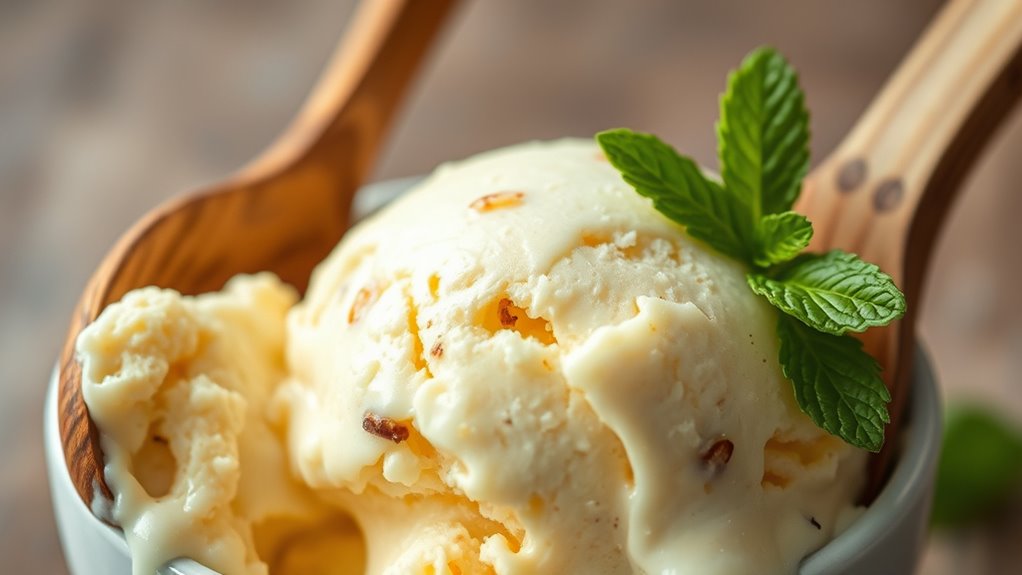To make a rich butter ice cream, emulsify 2 cups of heavy cream and 1 cup of whole milk with 2 tablespoons melted unsalted butter, 3/4 cup sugar, 1 teaspoon vanilla, and a pinch of salt. Heat until the emulsion forms, then chill promptly to 4°C. Maintain precise timing, temperatures, and steady agitation during churning to minimize air and ice crystals. Serve at -6 to -8°C with light garnishes; full method awaits your next step.
Ingredients and Quantity
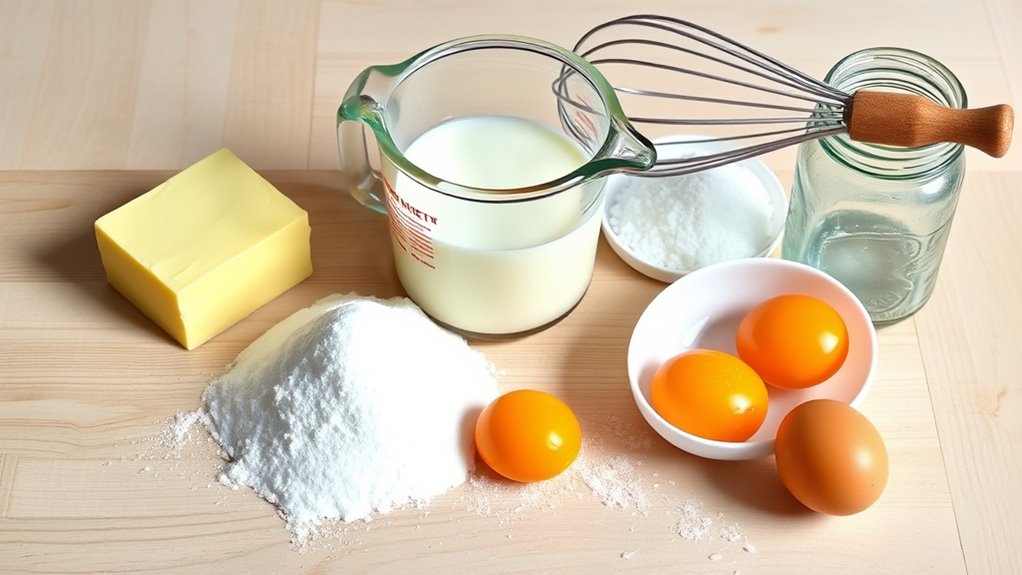
To make butter ice cream, gather the following ingredients and quantities: heavy cream, 2 cups; whole milk, 1 cup; unsalted butter, 2 tablespoons melted; sugar, 3/4 cup; vanilla extract, 1 teaspoon; and a pinch of salt.
Precision matters here, because ingredients set the texture, flavor, and sourcing footprint. You’ll compare butter types to influence mouthfeel and richness, then consider flavor variations to align with taste freedom. The table highlights key contrasts and choices.
| Butter type focus | Flavor variation impact |
|---|---|
| Grass-fed, cultured | Nutty, caramel notes |
Choose local, transparent sourcing, and document proportions to guide consistent results.
Preparations

Preparations involve organizing and executing the base steps with exactness: melt and emulsify the butter into the warm liquids, chill the mixture promptly, and set up the churning plan with sourced ingredients at ready temperatures. You’ll log temperatures, timings, and ingredient integrity, ensuring consistency across batches. Focus on measurement accuracy, vial labeling, and clean equipment to prevent contamination. The churning technique should be prepped with validated speeds, minimal air incorporation, and controlled duration for texture. Consider flavor variations by noting butter purity, cream origin, and any add-ins sourced in advance. Maintain traceable steps so you can reproduce results or iterate. This phase is about discipline and freedom: precise processes that empower you to craft reliable, high-quality ice cream with confident control over outcomes.
How to Cook
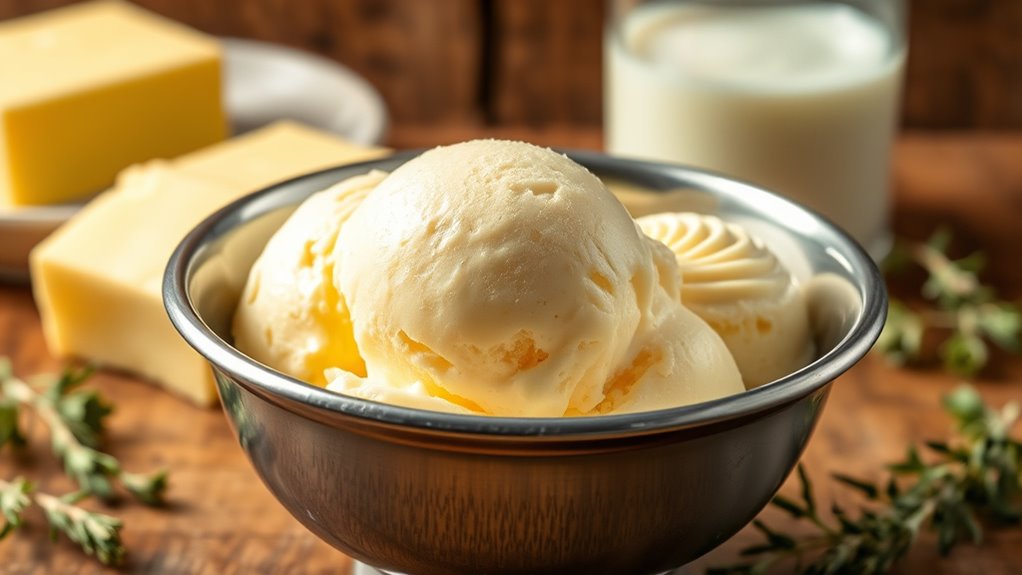
- Assemble all ingredients and equipment before starting.
- Heat butter into the liquid base until smoothly emulsified and just below simmering temperature.
- Control texture by managing precise timing, temperature, and agitation.
- Document each step carefully for consistency and repeatability.
- Focus on balancing emulsification consistency, fat distribution, and cooling rate.
- Perform shallow tests to confirm texture and adjust as needed.
- Check braising temperature regularly to prevent separation.
- Incorporate fat gradually to maintain a stable emulsion.
- Maintain a steady agitation cadence to keep the mixture smooth.
- Introduce flavor variations through controlled infusions.
- Use high-fat cream and stable emulsifiers if desired.
- Source clean, high-quality ingredients mindfully.
- Be precise in technique while allowing room for experimentation.
- Observe how minor adjustments impact mouthfeel, aroma, and finish.
- Preserve the fundamental butter-forward flavor profile throughout.
How to Serve
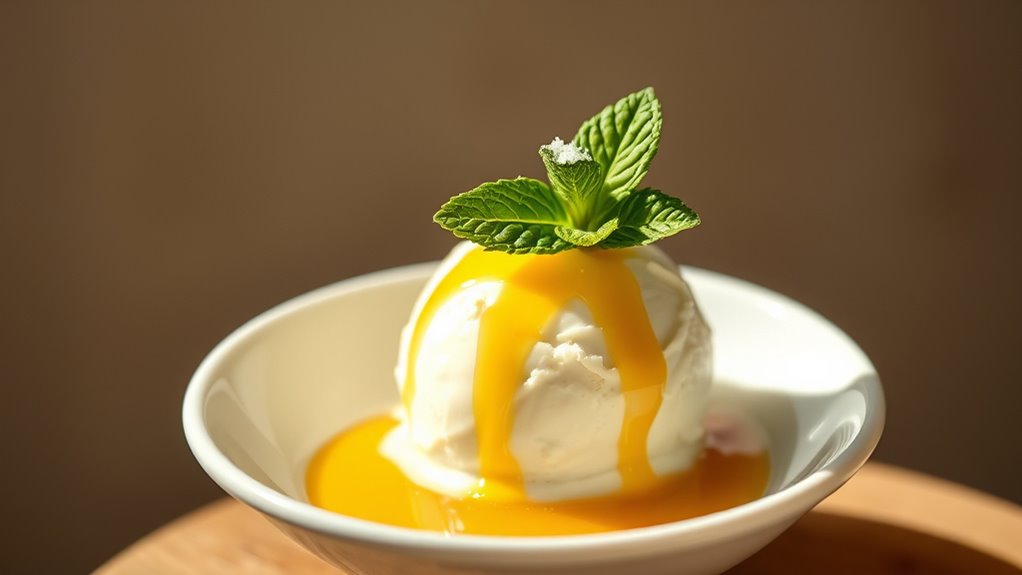
Serve the butter ice cream with deliberate contrast and clear portioning. You’ll guide the texture and temperature to align with your palate, choosing a serving temperature near -6 to -8°C for ideal scoopability. Pair it with a neutral or lightly sweet accompaniment that enhances, not competes with, its richness. Serve in petite bowls or shallow dishes to emphasize presentation ideas and allow easy portion control. Consider a thin drizzle of honey, a pinch of sea salt, or a citrus twist to sharpen flavor without masking it. For serving suggestions, place a single herb leaf or crisp wafer to add color and structure. Focus on consistency, sourcing quality ingredients, and clean plating to convey intentional, freedom-forward discipline.
Tips
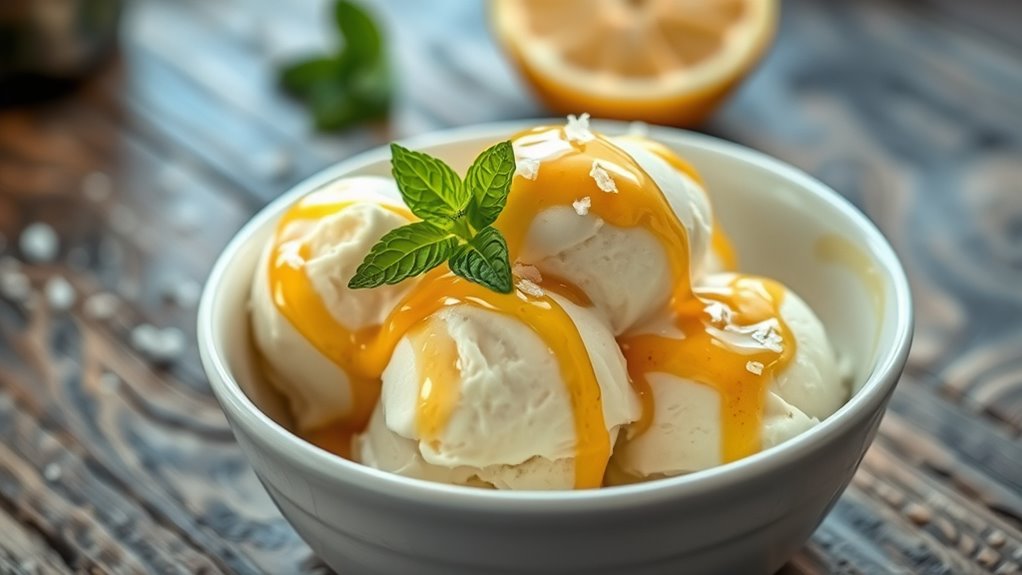
To optimize texture and flavor, start with precise temperature control: confirm your ice cream base chills to 4°C before churning, then freeze to -6 to -8°C for ideal scoopability.
- Maintain consistent agitation and avoid air incorporation that excesses volume
- Incorporate stable emulsifiers to sharpen butter notes and mouthfeel
- Experiment with flavor variations using controlled additions near finish
- Tag cooking times and temperatures to track reproducibility
Proceed with disciplined timing, recording deviations and outcomes for reproducibility. Source your ingredients and equipment from trusted suppliers to guarantee consistency. For flavor variations, test small batches before scaling, noting sweetness, salt, and dairy balance. Storage tips: keep churning temp steady, portion promptly, and seal to prevent ice crystal growth. This methodical approach supports freedom in experimentation while preserving texture, flavor, and stability across batches.
Food Value and Benefit
Butter ice cream offers a rich and creamy dairy experience, combining high-quality cream and milk churned at controlled temperatures for optimal texture and flavor.
Food Value:
- Contains fats from dairy, providing energy and aiding in the absorption of fat-soluble vitamins.
- Provides protein essential for muscle repair and overall body function.
- Supplies calcium, important for bone health.
- Contains vitamins A and D, which support vision, immune function, and calcium metabolism.
- Includes minerals such as phosphorus and potassium, contributing to bone strength and electrolyte balance.
Benefits of Eating Butter Ice Cream:
- Supports bone health through calcium and vitamin D content.
- Provides a source of energy from healthy fats.
- Contains protein that supports tissue repair and growth.
- Offers vitamins and minerals that contribute to overall wellness.
- Can be enjoyed in moderation as part of a balanced diet.
Enjoying butter ice cream in appropriate portions allows you to indulge in its creamy texture and rich flavor while benefiting from key nutrients found in dairy.
Frequently Asked Questions
How Long Can Butter Ice Cream Be Stored Frozen?
Ever wondered how long you can store butter ice cream? You can keep it frozen for about 2–3 months. Storage duration and freezer safety matter; monitor texture, avoid freezer burn, and label dates for precise sourcing and freedom.
Can I Substitute Heavy Cream With Milk in This Recipe?
Yes, you can; however, you’ll miss richness. Use heavy cream substitutes or milk alternatives, aiming for higher fat content, and adjust sugar. Precision: test small batches, document outcomes, and source guidance for best results.
Will Vegan Margarine Work for Flavor and Texture?
Yes, vegan margarine can work, but expect a different texture. To optimize flavor profile, choose vegan butter with stable emulsifiers, chill thoroughly, and adjust sweetness. You’ll discover a precise, methodical approach supports your freedom to experiment.
Is There a Dairy-Free Alternative to Butter Ice Cream?
Yes, you can: try dairy-free options like coconut or almond milk bases, then use vegan emulsifiers and stabilizers. Source high-quality ingredients, test ratios, and document results to optimize texture, flavor, and consistency for a自由, precision-driven vegan ice cream.
Can I Use a Ice Cream Maker Without Churning?
Yes, you can. You’ll use Ice cream maker, but alternative methods exist if you don’t churn; freeze in a shallow container, whisk occasionally. Precision: monitor texture, reduce dairy alternatives, document steps, source techniques, guarantee smoothness and freedom.
